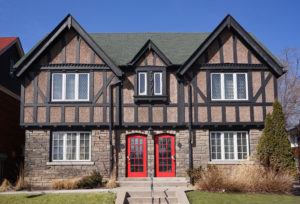 If there is one style of architecture that stands out noticeably amongst the rest, it’s the Tudor style of home. Love them or hate them, you have to admit that Tudors have a particular charm that you would be hard-pressed to find in any other style. This is in due part to the fact that Tudors combine elements of late-medieval and early-Renaissance architecture wrapped in a Craftsmen encasing. The Tudor home is a combination of styles, but nevertheless, achieves a look all its own.
If there is one style of architecture that stands out noticeably amongst the rest, it’s the Tudor style of home. Love them or hate them, you have to admit that Tudors have a particular charm that you would be hard-pressed to find in any other style. This is in due part to the fact that Tudors combine elements of late-medieval and early-Renaissance architecture wrapped in a Craftsmen encasing. The Tudor home is a combination of styles, but nevertheless, achieves a look all its own.
Unfortunately, the majority of Tudor homes in New England and around the U.S are unbelievably expensive. This is in large part to the type of materials required and the amount necessary to perform the job. Fret not. If a Tudor home is what your heart desires, you can still achieve a Tudor-inspired home in your existing house. From historic reproduction doors to the design of the roof, we show you what it takes to turn your existing home into a Tudor home of your own.
Materials
A home designed in the Tudor style typically incorporates a multitude of materials that can be divided into two sections: top half and bottom half. The materials for the top half of the home are usually wood and either stucco or plaster. This creates the decorative timbers that are indicative of Tudor architecture. For the bottom half, you can incorporate brick, stone or wood, with brick being the most common.
Doors and Windows
The doors and windows that are incorporated in Tudor homes are very distinct. Using the right doors and windows is extremely important for pulling off the entire look. Instead of traditional double hung windows, you’ll find that Tudors use casement windows arranged in tidy rows instead. The door of a Tudor home is typically wood paneled and often rounded. This is why many people opt for historic reproduction doors and windows to guarantee that the look can be achieved successfully.
Post and Beams
Just like the doors and windows, post and beams are equally as important to the overall look of successfully creating a Tudor-styled home. This is a major part of the character to the home and is what makes a Tudor home readily identifiable no matter where you are. To achieve this look, the post and beams need to be arranged as the frame and then filled in with the stucco or plaster.
Creating the Tudor home of your dreams isn’t far from reality. These simple changes can all be easily adapted for your existing home; turning your current home into a dream castle.




